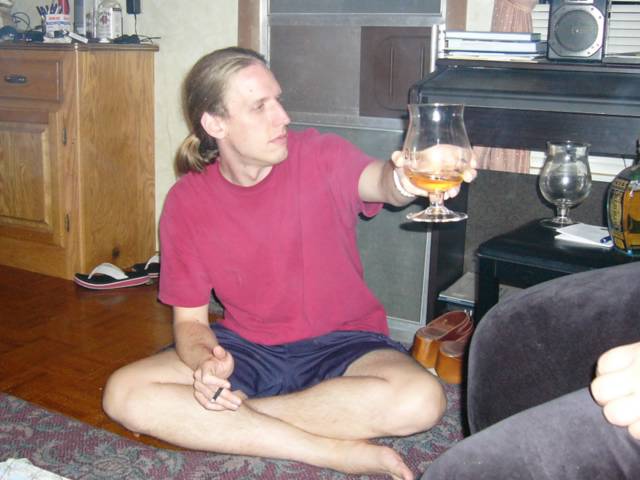Merry Monks, my Singel, and Ardennes yeast
Some random tasting. . .
Weyerbacher Merry Monks' Belgian Style Golden Ale:
Something I picked up at Marcy. Rich golden color. Weak, quickly dissipating head. Nose has some interesting esters and a little hint of sourness, but also a suggestion of slightly cloying malt. The 9.3 abv is well-concealed in the nose, but I still find the palate too malty and sweet. To say it's genuinely cloying would be a little harsh, but it lacks crispness and snap, leaning toward the richer maltier end--which is not always bad, but not entirely to my taste for this style. So there's nothing really wrong with this, but I'm unimpressed. It would taste very flaccid next to, say, a Duvel or a Chimay Cinq Cents.
By way of an apples-and-oranges comparison, here's my own "Trappist" Singel:
Still pale gold, but a slightly duskier shade. Big, billowy, retentive head. Interesting nose: Sour fruit, tea, herbs, sourdough bread, definitely caraway seed. Palate is crackery and dry, but not without body. Moderately sour, which is crucial for balance here. Lingering noble hop character and some delicate graininess to the finish. The grotesquely hot weather gives this lighter, sharper beer an advantage over the commerical one, but I wasn't really trying to have a contest. I like my singel though. It was a shot-in-the-dark recipe, blending pilsner, wheat, and biscuit malts with Spalt and Hallertau hops and the rather declamatory Wyeast 3787 yeast. I'm trying to get a little more disciplined and precise in my Belgian recipe writing, but if you use a characterful yeast and good quality malts, it's actually hard -not- to make a relatively yummy beer. For the record, however, I think the 3787 is better suited to bigger beers.
On one other note: I'll develop this thought later, but I just tasted the first glass of my new Belgian pale ale on tap and I have two observations. 1) Saaz dry-hopping comes out really Belgian-y. 2) The Belgian Ardennes yeast strain produces a spectacularly complex spiciness. I dig it. Reminded me of some of the things I picked up in the Fantome last night. I could imagine a really profound set of aromatics coming out of a Saison beer pitched with a combination of the Dupont and Chouffe yeasts. That might make an interesting project next summer--they both like the hot temps.
Weyerbacher Merry Monks' Belgian Style Golden Ale:
Something I picked up at Marcy. Rich golden color. Weak, quickly dissipating head. Nose has some interesting esters and a little hint of sourness, but also a suggestion of slightly cloying malt. The 9.3 abv is well-concealed in the nose, but I still find the palate too malty and sweet. To say it's genuinely cloying would be a little harsh, but it lacks crispness and snap, leaning toward the richer maltier end--which is not always bad, but not entirely to my taste for this style. So there's nothing really wrong with this, but I'm unimpressed. It would taste very flaccid next to, say, a Duvel or a Chimay Cinq Cents.
By way of an apples-and-oranges comparison, here's my own "Trappist" Singel:
Still pale gold, but a slightly duskier shade. Big, billowy, retentive head. Interesting nose: Sour fruit, tea, herbs, sourdough bread, definitely caraway seed. Palate is crackery and dry, but not without body. Moderately sour, which is crucial for balance here. Lingering noble hop character and some delicate graininess to the finish. The grotesquely hot weather gives this lighter, sharper beer an advantage over the commerical one, but I wasn't really trying to have a contest. I like my singel though. It was a shot-in-the-dark recipe, blending pilsner, wheat, and biscuit malts with Spalt and Hallertau hops and the rather declamatory Wyeast 3787 yeast. I'm trying to get a little more disciplined and precise in my Belgian recipe writing, but if you use a characterful yeast and good quality malts, it's actually hard -not- to make a relatively yummy beer. For the record, however, I think the 3787 is better suited to bigger beers.
On one other note: I'll develop this thought later, but I just tasted the first glass of my new Belgian pale ale on tap and I have two observations. 1) Saaz dry-hopping comes out really Belgian-y. 2) The Belgian Ardennes yeast strain produces a spectacularly complex spiciness. I dig it. Reminded me of some of the things I picked up in the Fantome last night. I could imagine a really profound set of aromatics coming out of a Saison beer pitched with a combination of the Dupont and Chouffe yeasts. That might make an interesting project next summer--they both like the hot temps.


0 Comments:
Post a Comment
<< Home